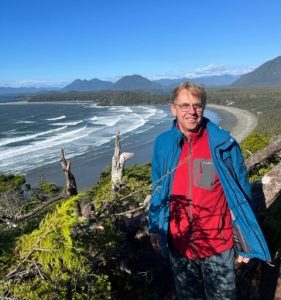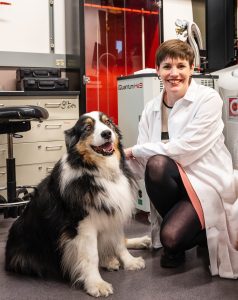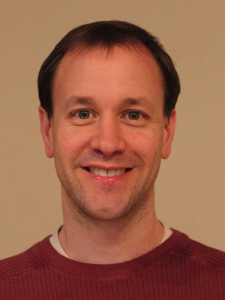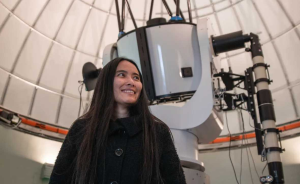Dr. Claudia Gomes da Rocha
Modelling Nanoscale Quantum Materials: From Sensing to Neuromorphic Applications
About: As a faculty member of the Department of Physics and Astronomy, University of Calgary, Dr. Rocha leads the Complex Nano Materials group whose research targets problems in theoretical condensed matter physics, computational nanoscience, and quantum materials realms. Her research has also an interdisciplinary scope touching the boundaries of neuroscience, computer science, and nanotechnology. Dr. Rocha is also a member of the Institute for Quantum Science and Technology, Quantum Alberta, and the Hotchkiss Brain Institute. Dr. Rocha received her MSc (2001) and PhD (2005) degrees in Physics from the Fluminense Federal University (FFU) in Rio de Janeiro, Brazil. There followed a series of postdoctoral experiences in Europe: research fellow at Trinity College Dublin (TCD), Ireland, (2005-2008); Alexander von Humboldt Fellow at Dresden University of Technology, Germany (2008-2011); independent researcher at the University of Jyväskylä, Finland (2011-2014); and senior research fellow at TCD, Ireland (2014-2018).
Abstract: Most of the electronic novelties existent nowadays are engineered with building-block components and materials at the nanometer scale from which intriguing quantum physical phenomena emerge. Ultimate nanomaterials are precisely tailored in nanoscale circuits and sophisticated microchips, core components in modern computation. Modern computers can solve problems of unimaginable complexity and continue to become faster thanks to miniaturization methods that make device components at the nanoscale. However, this trend is slowing down because of the inherent physical constraints of electrons moving through matter. In this way, I will showcase some of my works aimed at investigating — with computational models and simulations — non-conventional nanomaterials engineered for specific technological applications that will enhance our understanding and ability to manipulate and utilize these systems in innovative smart technologies: (i) neuromorphic (brain-like) systems viewed as next-generation computing devices that process information like neurons in the brain, (ii) transparent conducting films to enhance durability in existing touch screens and flexible display technologies, (iii) molecular chemical sensors for accurate detection of chemical impurities in the environment, and (iv) quantum materials to enable the quantum technologies of the future.
Dr. Johannes Gemmrich
The Physics of Rogue Waves
 About: Dr. Johannes Gemmrich is a Physical Oceanographer and Adjunct Associate Professor in the Department of Physics and Astronomy at the University of Victoria. For more than 30 years he has been conducting sea-going and theoretical research on the interaction between the oceans and the atmosphere. His research brought him to diverse regions including the tropical waters off Hawaii, the North Pacific during hurricane-forced winds, and the ice-covered Canadian Arctic Archipelago. (Website:)
About: Dr. Johannes Gemmrich is a Physical Oceanographer and Adjunct Associate Professor in the Department of Physics and Astronomy at the University of Victoria. For more than 30 years he has been conducting sea-going and theoretical research on the interaction between the oceans and the atmosphere. His research brought him to diverse regions including the tropical waters off Hawaii, the North Pacific during hurricane-forced winds, and the ice-covered Canadian Arctic Archipelago. (Website:)
Abstract: The presentation will include a brief introduction to physical oceanography – a discipline that spans more than 10 orders of magnitude in space and time, providing challenging physics with a wide societal impact. The focus of the talk will be on the physics of ocean surface waves. In particular, the understanding and prediction of so-called rogue waves, i.e. anomalously large waves that can be dangerous to shipping and offshore operations, as well as for people and infrastructure on the coast.
Dr. Allanah Hallas
Crystal Clear: Making Sense of the Structure of Matter
 About: Alannah Hallas is an Associate Professor of Physics at the University of British Columbia, a Principal Investigator at the Blusson Quantum Matter Institute, and the Co-Director of CIFAR’s Quantum Materials Program. Alannah’s research centers on the design and discovery of new magnetic quantum materials, whose quantum properties she studies using x-rays, neutrons, and muons. When she’s not growing crystals or at the beamline, Alannah loves cooking (and eating!), playing bridge, and learning to sail in the waters around beautiful British Columbia. (Group website:)
About: Alannah Hallas is an Associate Professor of Physics at the University of British Columbia, a Principal Investigator at the Blusson Quantum Matter Institute, and the Co-Director of CIFAR’s Quantum Materials Program. Alannah’s research centers on the design and discovery of new magnetic quantum materials, whose quantum properties she studies using x-rays, neutrons, and muons. When she’s not growing crystals or at the beamline, Alannah loves cooking (and eating!), playing bridge, and learning to sail in the waters around beautiful British Columbia. (Group website:)
Abstract: The word “crystal” brings to mind images of gemstones in museum galleries or expensive jewels adorning a crown and scepter. In reality, we don’t need to venture so far to find crystals: they surround us in our daily lives and can be found inside every electronic device. Crystals are also at the heart of all experimental work that takes place at the Blusson Quantum Matter Institute. However, unlike the crystals that form in nature over millennia, the crystals we study at Blusson QMI are grown in a laboratory in just days. In this talk, I will explain what crystals are, why they’re so important to quantum materials research, and how we grow them in our lab.
Dr. Mark Van Raamsdonk
Holography, Wormholes, and Cosmology
 About: My research is centered on the quest to find a quantum mechanical description of gravity and spacetime dynamics. This is essential to understand black holes, the big bang, and perhaps even the nature of spacetime itself. In the holographic approach to quantum gravity, ordinary spacetime can be seen to emerge from quantum physics. Recently, I have been interested in understanding whether we can use this holographic approach to understand cosmological questions such as the nature of dark energy and the origin of structure in the universe. (Website)
About: My research is centered on the quest to find a quantum mechanical description of gravity and spacetime dynamics. This is essential to understand black holes, the big bang, and perhaps even the nature of spacetime itself. In the holographic approach to quantum gravity, ordinary spacetime can be seen to emerge from quantum physics. Recently, I have been interested in understanding whether we can use this holographic approach to understand cosmological questions such as the nature of dark energy and the origin of structure in the universe. (Website)
Abstract: In this talk, I’ll describe how ordinary spacetime might arise from quantum physics (in what’s known as the holographic approach to quantum gravity), how our universe might be related to a giant wormhole, and how this picture can lead to predictions for cosmology (such as decreasing dark energy and an eventual big crunch).
.
Dr. Max Swiatlowski
The Hunt for the Higgs Boson and Beyond
 About: Max Swiatlowski is a research scientist at TRIUMF, Canada’s Particle Accelerator Centre. He works primarily on the ATLAS experiment at CERN, where he helps lead the collaboration’s efforts in triggering and reconstructing particles produced in collisions of protons. He is also investigating novel and wide-ranging applications of deep learning, applying these ideas to enable fast simulations, improvements to analyses, and better particle triggering and reconstruction. Before coming to TRIUMF, he was a McCormick Fellow at the University of Chicago, and received his PhD from Stanford University and his AB from Harvard University. In his spare time, he likes to cook, run, cycle, and spend time in the mountains. Website:
About: Max Swiatlowski is a research scientist at TRIUMF, Canada’s Particle Accelerator Centre. He works primarily on the ATLAS experiment at CERN, where he helps lead the collaboration’s efforts in triggering and reconstructing particles produced in collisions of protons. He is also investigating novel and wide-ranging applications of deep learning, applying these ideas to enable fast simulations, improvements to analyses, and better particle triggering and reconstruction. Before coming to TRIUMF, he was a McCormick Fellow at the University of Chicago, and received his PhD from Stanford University and his AB from Harvard University. In his spare time, he likes to cook, run, cycle, and spend time in the mountains. Website:
Abstract: The discovery of the Higgs boson in 2012 wasn’t just “yet another stamp” to add to the collection: this enigmatic new particle acts unlike any other particle we’ve observed, and turns out to be the cornerstone of the Standard Model (SM). The story didn’t end just with discovery, and over the past decade physicists have been hard at work measuring its properties and trying to understand whether its mysteries might be related to physics beyond the SM. This talk will give an overview of the SM and the Higgs’ central role, will describe how particles are discovered at machines like the Large Hadron Collider, and explain how physicists today are still grappling with the fundamental questions posed by the Higgs.
Dr. Joanna Woo
The Diverse Lives of Galaxies
 About: Dr. Joanna Woo is an astrophysicist who researches galaxy evolution using a variety of cutting-edge observational and theoretical tools. While studying for a B.Sc. in Physics and Astronomy from UBC, Joanna established and became the president of the UBC Astronomy Club which is still active to this day. Being the adventurous type, Joanna decided to pursue graduate studies at the Hebrew University in Jerusalem, receiving her Ph.D. in 2014. She then moved to beautiful Switzerland to take up a postdoctoral position at the Institute for Astronomy of ETH Zurich before returning to Canada for a postdoctoral position at UVic. In mid-2019 Joanna joined the faculty at the Department of Physics at SFU where she is also the director of the Trottier Observatory.
About: Dr. Joanna Woo is an astrophysicist who researches galaxy evolution using a variety of cutting-edge observational and theoretical tools. While studying for a B.Sc. in Physics and Astronomy from UBC, Joanna established and became the president of the UBC Astronomy Club which is still active to this day. Being the adventurous type, Joanna decided to pursue graduate studies at the Hebrew University in Jerusalem, receiving her Ph.D. in 2014. She then moved to beautiful Switzerland to take up a postdoctoral position at the Institute for Astronomy of ETH Zurich before returning to Canada for a postdoctoral position at UVic. In mid-2019 Joanna joined the faculty at the Department of Physics at SFU where she is also the director of the Trottier Observatory.
Abstract: It has been long-established that galaxies can be divided into those that are star-forming spiral discs and those that are spheroids that have stopped forming stars long ago. Despite decades of attempts to fit galaxy evolution into a cookie-cutter model, it is becoming evident that galaxies grow and evolve from one class to the other through numerous evolutionary pathways. From passive evolution to the dramatic influence of black hole activity driving gaseous outflows, to the influence of the vast cosmic web, I will review the different drivers of galaxy evolution in light of the latest observational and theoretical discoveries. Drawing upon my own research, I will discuss issues of correlation and causation, and highlight evidence that points to multiple evolutionary pathways along which galaxies both grow and fade.
Stay tuned for further details on CUPC 2024 keynote speakers.

